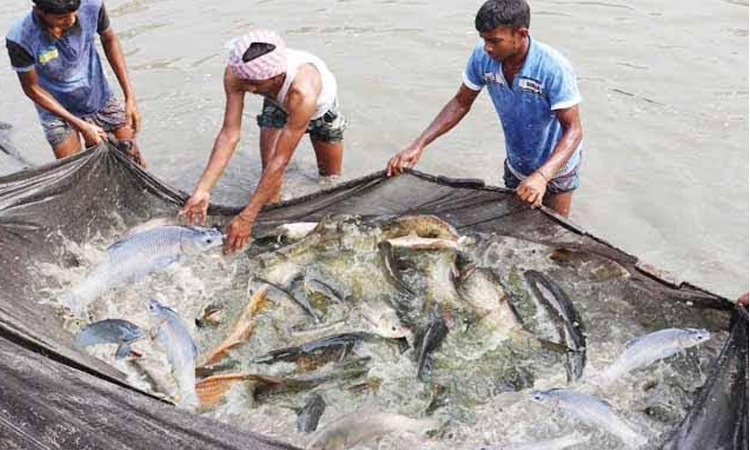News Flash

By Md Aynal Haque
RAJSHAHI, Oct 28, 2025 (BSS) - Mixed fish farming is rapidly gaining popularity and profitability across the Rajshahi region as farmers adopt innovative methods such as polyculture, integrated rice-fish farming, and shrimp-fish mixed culture.
These sustainable practices are maximizing resource use, enhancing incomes, and strengthening local food security.
According to the Department of Fisheries (DoF), various initiatives including training programs, infrastructure development, and the establishment of fish sanctuaries and beel nurseries are helping farmers embrace modern fish farming techniques. These efforts are not only improving livelihoods but also increasing the production of native and major carp species, thus contributing to the region's protein supply.
Fish farming has transformed the lives of many, lifting them out of poverty and improving their social status. In Beelsutir Beel at Dweep Pur Union in Bagmara Upazila, around 2,500 farmers have changed their fortunes through integrated paddy and fish farming.
"We leased the government water body of Beelsutir Beel for six years in 2018," said Amulya Hawlader, President of the Beelsutir Beel Fishermen Cooperative Society. "Since then, our members and nearby farmers have reaped the benefits of combining paddy and fish cultivation."
Landowners around the beel have also joined in and are earning equal benefits, directly or indirectly. To strengthen the initiative, a 326-member committee has been formed under the "Beelsutir Beel Fish Farming Project" to ensure better coordination and planned productivity.
As part of the project, irrigation is provided free of cost to members' farmlands, significantly boosting both paddy and fish yields throughout the year.
Local resident Syed Ali said farmers are now able to grow potato, onion, maize, and boro and aush paddy using the integrated method. Dweep Pur Union Parishad Chairman and project director Mukhlesur Rahman added that three deep tube-wells have been installed to supply irrigation water, while two shallow machines help drain excess water, both of which have greatly benefited local farmers.
Rahman noted that composite fish farming, which combines fish cultivation with poultry, vegetables, and fruits, is also gaining momentum across the region. This approach meets rising nutritional demands while increasing farmers' earnings.
Many farmers have set up small poultry farms and vegetable gardens around their ponds, earning additional income.
Shafiqul Islam, a fish farmer from Keshorhat village in Mohanpur Upazila, owns five large ponds covering about 75 bighas of water area. Alongside his ponds, he runs chicken and duck farms and grows vegetables, regularly supplying live fish to Dhaka by truck. Over the past decade, he has earned around Tk 1 crore from his integrated farming, creating employment opportunities for others.
Similarly, Anwar Hossain of Boilsingh in Bagmara Upazila has become a local icon in composite farming. He operates 22 ponds and has significantly contributed to the local economy through integrated fish, poultry, and vegetable farming.
Training and technical support, Hossain emphasized, would further enhance farmers' knowledge, improve productivity, and reduce risks.
Ashraf Ali of Bardhanpur village in Durgapur Upazila has also found long-term success, maintaining 20 ponds for composite fish farming over the past two decades. With his earnings, he has even established a fish feed factory in his locality.
According to Sohrab Hossain, General Secretary of the District Fish Farmers Association, more farmers are now adopting modern, eco-friendly fish farming methods and moving away from conventional practices. "To produce safe and chemical-free fish, there is no alternative to modern farming," he said.
Divisional Deputy Director of Fisheries Saifuddin Yahia noted that Rajshahi's environment is highly suitable for composite fish farming. He explained that polyculture involves rearing compatible fish species with different feeding habits in the same pond to make optimal use of natural resources.
Farmers are also combining rice and fish cultivation, where fish stocked in paddy fields help fertilize the crops naturally and are protected from predators. Yahia added that farmers are increasingly interested in integrating freshwater shrimp and prawn farming with major carp species such as Rui, Katla, and Silver Carp, further diversifying production and boosting income.